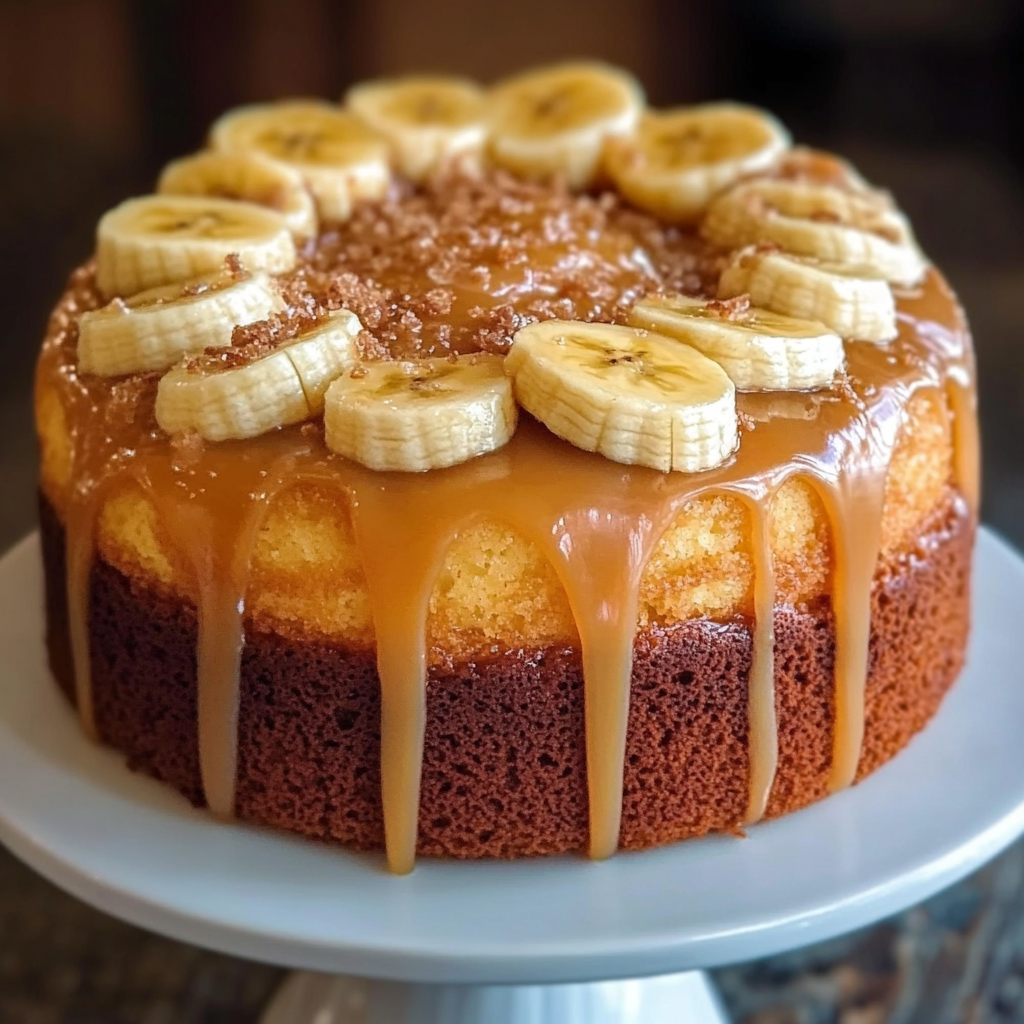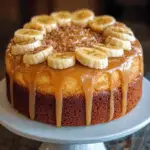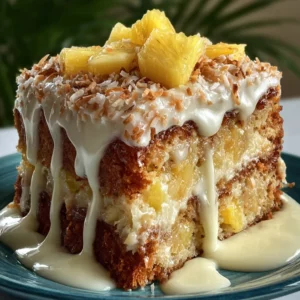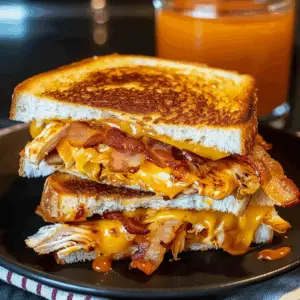There’s something undeniably charming about desserts that flip the script—banana upside down cake is one of those rare treats that combines nostalgic comfort with visual wow-factor. This cake brings together the caramelized richness of bananas with a moist, fluffy cake base, resulting in a dessert that’s as satisfying as it is simple to make.
Unlike the traditional pineapple upside down cake, this version uses ripe bananas for a more decadent, natural sweetness. The magic begins at the bottom of the pan, where butter and brown sugar blend into a gooey caramel layer that infuses the fruit as it bakes. After a swift flip, the golden banana slices crown the cake in a glossy, irresistible finish. It’s a dessert that’s perfect for those looking to upgrade their banana bread game with minimal effort.
Beyond its delicious appeal, this cake offers a lesson in culinary chemistry. The caramelization process transforms the bananas into something more intense and layered in flavor (source). The way the sugar and fruit meld into the butter highlights how baking techniques can elevate basic ingredients. If you’re new to baking or seeking a dependable, rewarding project, this dessert deserves a spot on your list.
Explore more inspiration on upside down cakes from this Pinterest collection, showcasing creative takes and presentation styles. And if you’re curious about the broader history of cakes and their evolution through cultures, the Wikipedia page on cakes provides rich context on how desserts like this became staples in kitchens around the world.
Whether you’re a banana dessert enthusiast, a nostalgic baker, or someone simply looking to wow guests without complicated steps, the banana upside down cake stands out as a timeless favorite with a modern twist.
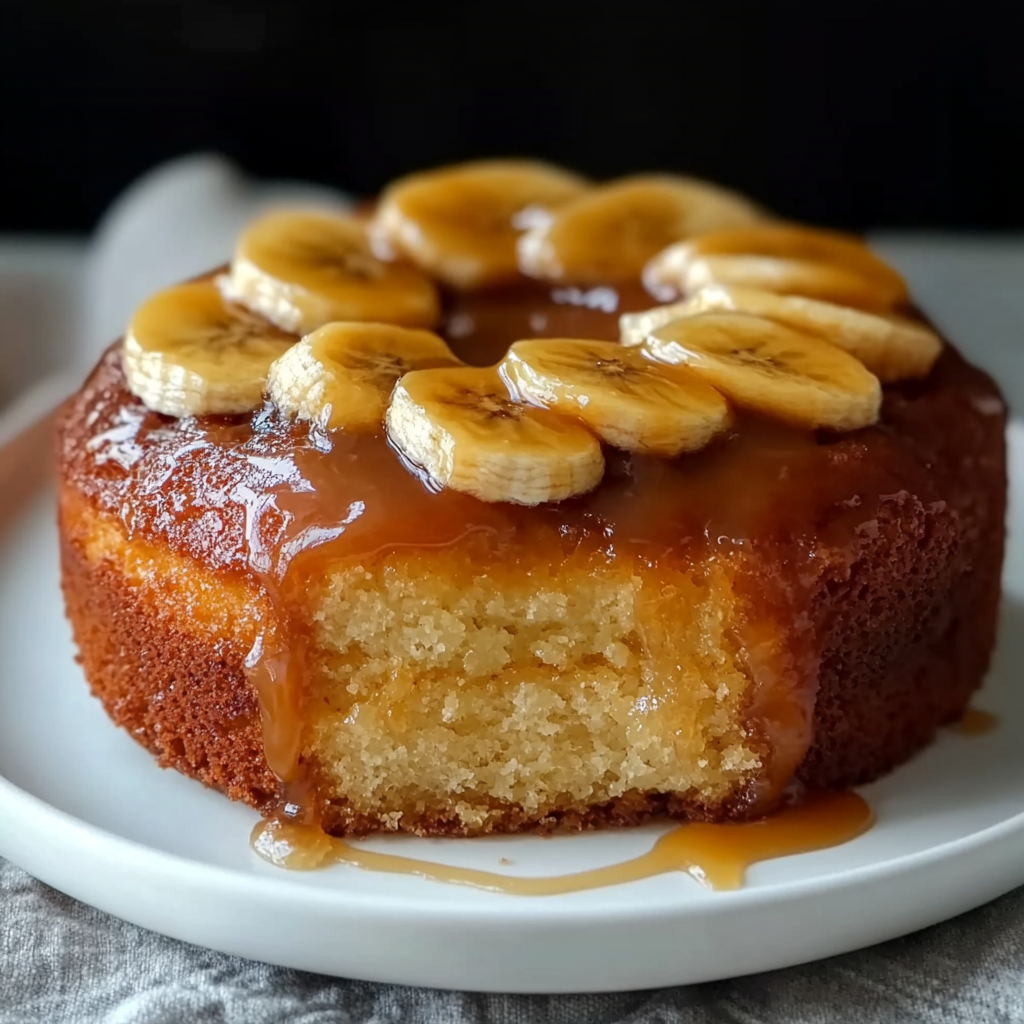
What Is an Upside Down Cake?
An upside down cake is a classic dessert that flips traditional baking on its head—literally. Instead of adding fruit or toppings after baking, these ingredients are placed at the bottom of the pan, topped with cake batter, and then inverted after baking to reveal a caramelized, fruit-laden crown. This method not only enhances flavor but also creates a beautiful, naturally glazed top.
The most iconic version is the pineapple upside down cake, which gained popularity in the early 20th century thanks to canned pineapple rings and maraschino cherries. However, variations like the banana upside down cake offer a richer, more comforting twist. Bananas, with their soft texture and natural sweetness, lend themselves perfectly to this technique. They absorb the butter and brown sugar caramel, becoming tender and intensely flavorful.
The technique of baking “upside down” has roots in rustic fruit desserts, where fruit was cooked first and topped with a quick batter. Over time, this evolved into a full-fledged dessert style that balances moisture and texture in a single pan. More than a gimmick, this method ensures that the fruit layer remains juicy while the cake stays fluffy.
For a closer look at how flour, one of the key ingredients in the batter, plays a role in the structure of cakes like this, the Wikipedia entry on flour is a helpful read. Meanwhile, Pinterest boards like this collection of banana dessert ideas can inspire new twists on presentation and flavor combinations for your own creations.
So, when someone asks what is an upside down cake, it’s not just about the method—it’s about transforming simple ingredients into something beautiful, delicious, and surprisingly easy to make.
Why Banana Is the Perfect Twist
When it comes to upgrading traditional upside down cakes, few ingredients shine as brilliantly as the banana. Naturally sweet, rich in moisture, and packed with flavor-enhancing sugars, bananas offer an ideal alternative to more commonly used fruits like pineapple or peaches. Their ability to caramelize beautifully when baked makes them a standout choice for this recipe.
One of the main reasons bananas work so well in this dessert is due to their high sugar content, particularly when overripe. As they bake under the butter and brown sugar topping, the bananas soften and take on a deep, toffee-like flavor. This not only enhances the taste but creates a melt-in-your-mouth texture that complements the soft cake layer above.
Bananas also have a binding quality that adds moisture to baked goods. Unlike other fruits, they break down and integrate easily into both the topping and the cake batter. This helps achieve the ideal consistency—a moist, tender crumb that stays fresh longer than most cakes.
Their versatility is another asset. While the banana upside down cake is already a complete dessert on its own, it also pairs well with other ingredients like cinnamon, chocolate chips, or even a splash of dark rum. A deeper dive into the Wikipedia article on bananas reveals more about their nutritional profile and widespread use in cooking and baking around the world.
For presentation ideas or ways to experiment with banana-based desserts, you might find inspiration in this Pinterest baking board filled with inventive techniques and finishing touches. Bananas aren’t just a kitchen staple—they’re the secret weapon that turns a good cake into an unforgettable one.
A Brief History of Upside Down Cakes
Upside down cakes have a rich culinary history that reflects both practicality and creativity. Long before modern baking pans and ovens, people baked in cast iron skillets over open flames. In these early setups, it was common to place fruit and sugar at the bottom of the pan, add a simple batter on top, and cook it slowly over heat. Once done, the cake was flipped—revealing a rustic yet stunning fruit-topped dessert.
The concept gained significant popularity in the early 20th century, particularly with the invention of canned pineapple. This gave birth to the now-iconic pineapple upside down cake, which became a staple in American households during the 1920s and 30s. As the cake’s popularity spread, bakers began experimenting with other fruits, including bananas, apples, and peaches.
Modern variations, such as the banana upside down cake, are influenced by this historical evolution. They maintain the classic format—fruit caramelized under cake—but add new flavors and textures to suit contemporary tastes. If you’re curious to dive deeper into the development of traditional cakes, this Wikipedia page on the history of cakes offers a comprehensive look at how desserts evolved over centuries.
Today, this style of cake is celebrated not only for its taste but also for its dramatic presentation and ease of preparation. As baking trends shift toward nostalgic yet elevated comfort foods, the upside down cake continues to hold its place as both a crowd-pleaser and a canvas for culinary creativity. From humble skillet origins to elegant banana adaptations, it’s a dessert with timeless appeal.

Key Ingredients and Their Roles
Understanding the roles of each ingredient in a banana upside down cake helps ensure your cake turns out perfectly every time. From moisture to lift, sweetness to structure, every component plays a specific function.
For the Topping
-
¼ cup unsalted butter, melted: Creates the rich base of the caramel layer. It combines with the brown sugar to form a syrupy topping.
-
½ cup brown sugar, packed: Provides depth of flavor and caramelizes beautifully under heat, enhancing the banana topping.
-
2–3 ripe bananas, sliced lengthwise: Serve as the visual and flavor-forward topping. Ripe bananas caramelize well and soften without losing form.
For the Cake Batter
-
1½ cups all-purpose flour: The structural backbone of the cake. Learn more about its baking properties from Wikipedia.
-
1 tsp baking powder & ½ tsp baking soda: These leavening agents ensure a light, fluffy texture. See the differences and use-cases here.
-
¼ tsp salt: Balances the overall sweetness and enhances the other flavors.
-
½ cup unsalted butter, softened: Contributes to the cake’s richness and works with sugar to create an airy structure via the creaming method. Explore more about butter in baking.
-
½ cup granulated sugar: Adds sweetness and structure. Works with butter to create lightness.
-
2 large eggs: Provide structure and moisture, and bind the ingredients together.
-
1 tsp vanilla extract: Adds depth and warmth to the flavor profile.
-
½ cup sour cream: Moisture booster and slight tang that balances sweetness. Learn about sour cream in baking.
-
2 ripe bananas, mashed: Add flavor, moisture, and natural sweetness to the cake body.
Each ingredient works synergistically to produce a soft, tender cake with a caramelized banana top that’s both beautiful and bursting with flavor. This combination elevates a simple banana dessert into something truly next-level.
Best Type of Bananas to Use
Bananas are the star of this upside down cake, and choosing the right ones can make or break your dessert. The best bananas for baking are those that are very ripe to overripe—with peels that are speckled or nearly black. These bananas offer:
-
Enhanced sweetness: Overripe bananas have converted most of their starches into sugars.
-
Softer texture: Perfect for both layering and mashing into the batter.
-
Richer flavor: Baking intensifies the banana’s natural taste, making it more aromatic and dessert-like.
Avoid using green or barely yellow bananas—they’re too firm and lack sweetness. For more about banana ripeness and use in cooking, visit this banana breakdown.
If you find yourself with too many ripe bananas, this recipe is a fantastic way to use them up before they go to waste. You can also freeze bananas for future baking projects.
Optional Variations and Add-ins
Want to customize your banana upside down cake? Here are some exciting additions and variations that elevate the flavor or texture without complicating the process:
-
Spices: Add 1 tsp cinnamon or ¼ tsp nutmeg to the dry mix for warmth.
-
Nuts: Sprinkle chopped pecans or walnuts over the brown sugar layer before the bananas for added crunch.
-
Boozy twist: A tablespoon of rum or bourbon mixed into the topping adds a sophisticated kick.
-
Chocolate chips: Fold ½ cup into the batter for a banana-chocolate fusion.
-
Coconut flakes: Add a tropical flair by sprinkling unsweetened coconut over the banana layer.
These variations are a great way to personalize the cake and experiment with flavor profiles. For visual and creative inspiration, browse this Pinterest board of banana dessert ideas.
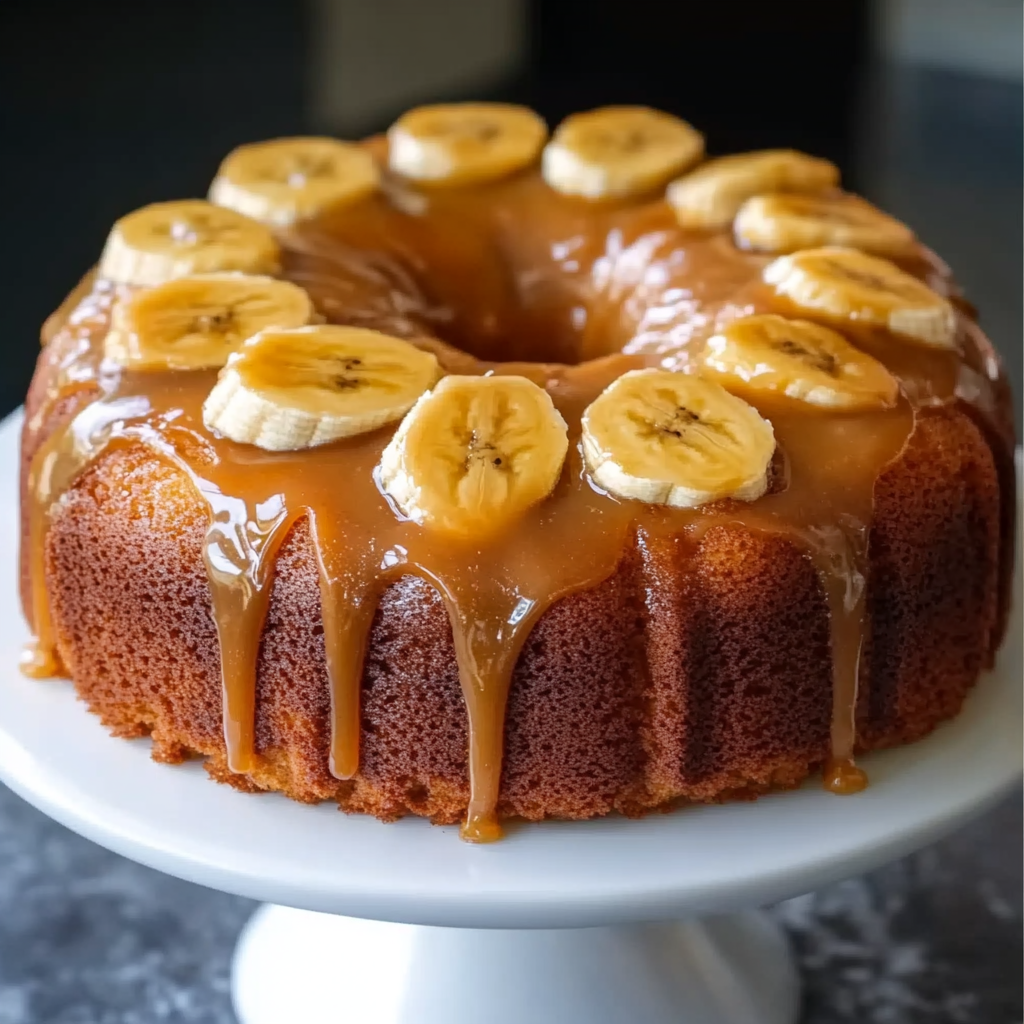
Frequently Asked Questions
Can I use frozen bananas for banana upside down cake?
Yes, you can use thawed frozen bananas, especially in the batter. However, they may release more moisture, so drain excess liquid before adding.
How ripe should bananas be for baking?
Overripe bananas—those with black or dark brown skins—are ideal for baking. They are sweeter and softer, making them perfect for both the topping and batter.
What’s the difference between banana bread and banana cake?
Banana bread is denser and often less sweet, while banana cake is lighter, fluffier, and sweeter. This upside down version offers the structure of a cake with the flavor of banana bread.
Can I make this cake gluten-free or vegan?
Yes, substitute with gluten-free flour and egg replacements like flax eggs. Use vegan butter and dairy-free sour cream alternatives. Keep in mind this may slightly alter texture.
Can banana upside down cake be made ahead of time?
Absolutely. It can be made a day ahead and stored at room temperature or in the fridge. Just reheat gently before serving to bring back the gooey texture
The Ultimate Banana Upside Down Cake Recipe for Sweet Lovers
A rich and moist banana upside down cake that flips the dessert world on its head! Caramelized banana slices baked in buttery brown sugar top a tender banana-infused cake base. Perfectly sweet, slightly tangy (thanks to sour cream), and full of warm flavor, this recipe is a must-bake for banana lovers and those seeking a crowd-pleasing dessert.
- Author: Clara
Ingredients
For the topping:
- ¼ cup unsalted butter, melted
- ½ cup brown sugar, packed
- 2–3 ripe bananas, sliced lengthwise
For the cake batter:
- 1 ½ cups all-purpose flour
- 1 tsp baking powder
- ½ tsp baking soda
- ¼ tsp salt
- ½ cup unsalted butter, softened
- ½ cup granulated sugar
- 2 large eggs
- 1 tsp vanilla extract
- ½ cup sour cream
- 2 ripe bananas, mashed
Instructions
Preheat the oven to 350°F (175°C). Grease a 9-inch round cake pan and line the bottom with parchment paper.
Pour the melted butter into the bottom of the pan and sprinkle the brown sugar evenly over it. Arrange the sliced bananas on top in a single layer.
In a medium bowl, whisk together the flour, baking powder, baking soda, and salt.
In a large bowl, cream the softened butter and granulated sugar together until light and fluffy. Add eggs one at a time, then mix in vanilla extract.
Mix in the mashed bananas and sour cream until well combined.
Gradually add the dry ingredients to the wet ingredients, mixing just until incorporated.
Pour the batter over the banana layer in the cake pan, spreading it evenly.
Bake for 40–45 minutes or until a toothpick inserted into the center comes out clean.
Let the cake cool in the pan for 10–15 minutes, then carefully invert onto a serving plate.
Allow to cool slightly before serving.
Notes
-
Use very ripe bananas for the best flavor and caramelization.
-
Grease your pan thoroughly and line with parchment to avoid sticking during flipping.
-
Allow the cake to cool slightly before inverting to ensure a clean release.
-
Serve warm with ice cream or whipped cream for an extra indulgent treat.
-
Store in an airtight container at room temperature for up to 2 days or refrigerate for longer freshness.
